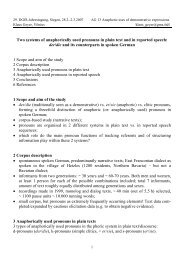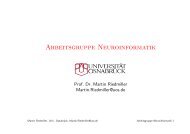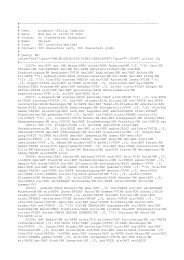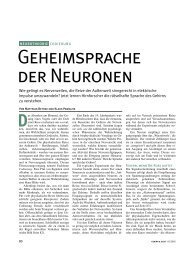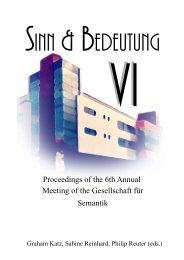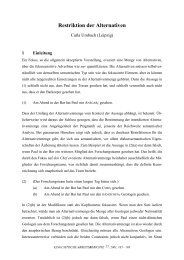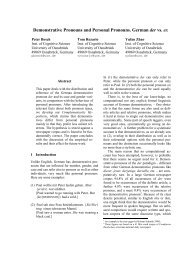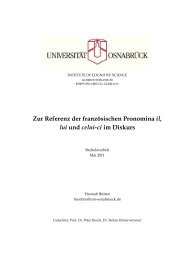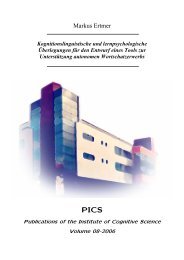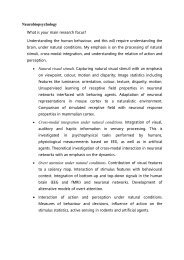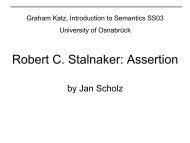Bound and referential pronouns - Cognitive Science
Bound and referential pronouns - Cognitive Science
Bound and referential pronouns - Cognitive Science
You also want an ePaper? Increase the reach of your titles
YUMPU automatically turns print PDFs into web optimized ePapers that Google loves.
<strong>Bound</strong> <strong>and</strong> <strong>referential</strong> <strong>pronouns</strong><br />
*with thanks to<br />
Birgit Bärnreuther,<br />
Christina Bergmann,<br />
Dominique Goltz,<br />
Stefan Hinterwimmer,<br />
MaikeKleemeyer,<br />
Peter König,<br />
Florian Krause,<br />
Marlene Meyer<br />
Peter Bosch<br />
Institute of <strong>Cognitive</strong> <strong>Science</strong><br />
University of Osnabrück<br />
Workshop on "<strong>Cognitive</strong> <strong>and</strong> linguistic mechanisms of<br />
anaphoric reference in literary <strong>and</strong> non-literary text"<br />
The plan<br />
1. Context: Are German demonstratives bound?<br />
2. Basic distinctions among pronoun occurrences<br />
3. An eye-tracking experiment<br />
Courant Research Center "Text Structures"<br />
Göttingen, 20.-21. Nov 2012<br />
2
DPro function <strong>referential</strong>ly – not bound<br />
Martina Wiltschko (1999):<br />
a) Peter glaubt, daß {er/der} dumm ist.<br />
[Peter believes that {he/DPro} is stupid.]<br />
b) [Jeder Mann] glaubt, daß {er/der} dumm ist.<br />
[Every man believes that {he/DPro} is stupid.]<br />
DPro function <strong>referential</strong>ly – not bound ?<br />
Hinterwimmer (2009) discusses sentences like the following<br />
– which seem to demonstrate that DPro can be bound by a<br />
c-comm<strong>and</strong>ing quantifying DP:<br />
(4) Klaus i stellte [jedem Studenten] k eine Frage, die der k nicht beantworten konnte.<br />
[Klaus put one question to [every student] k that [DPro k] could not answer.]<br />
3<br />
4
Pronouns may function in (at least <strong>and</strong> uncontroversially)<br />
two fundamentally different ways:<br />
(i) as free <strong>referential</strong> expressions ("R-expressions")<br />
(ii) as expressions that are syntactically <strong>and</strong> semantically<br />
bound by their antecedent ("anaphors")<br />
It is commonly assumed that<br />
Interpreting <strong>pronouns</strong><br />
reflexive <strong>and</strong> reciprocal <strong>pronouns</strong> are always bound,<br />
demonstrative <strong>pronouns</strong> are always free, <strong>and</strong><br />
personal (<strong>and</strong> possessive) <strong>pronouns</strong> may function either way.<br />
In a little more detail<br />
A pronoun may either<br />
Interpreting <strong>pronouns</strong><br />
1. refer autonomously – like any other <strong>referential</strong> expression,<br />
i.e., independent of the reference of other DPs, controlled<br />
only by the salience of its referent ("first mention pronoun").<br />
(1) This is my friend Karl.<br />
(2) She is the one who invited me to a Martini.<br />
2. it may depend on the interpretation of another DP – in one<br />
of several ways...
Interpreting <strong>pronouns</strong><br />
When the interpretation of a pronoun depends on another DP<br />
this may be due to<br />
i. the pronoun being c-comm<strong>and</strong>ed <strong>and</strong> syntactically bound<br />
by that DP.<br />
We speak here of bound <strong>pronouns</strong> (in a narrow sense of<br />
"bound").<br />
This relation is obviously only possible within a sentence<br />
<strong>and</strong> is not based on a relation of reference.<br />
(1) John thought he would be late.<br />
(2) Everyone thought he would be late.<br />
(3) Fred told Jane she would be late.<br />
Interpreting <strong>pronouns</strong><br />
When the interpretation of a pronoun depends on another DP,<br />
this may, alternatively, be due to<br />
ii. the pronoun occurring <strong>referential</strong>ly,<br />
a. referring to the same entity that is referred to by<br />
another <strong>referential</strong> DP in discourse (strict<br />
coreference)<br />
(4) John took the train. He went to Berlin.<br />
b. or referring to an entity that was introduced into the<br />
discourse indirectly by another, not necessarily<br />
<strong>referential</strong>, DP (discourse reference)<br />
(5) A man called. But he didn't leave a message.<br />
(6) John wanted to catch a fish. He wanted to eat it<br />
for dinner.
Interpreting <strong>pronouns</strong><br />
1. The pronoun refers autonomously<br />
2. The pronoun's interpretation depends on another DP<br />
i. The pronoun is c-comm<strong>and</strong>ed <strong>and</strong> thus syntactically<br />
bound by that DP (bound pronoun)<br />
ii. The pronoun occurs <strong>referential</strong>ly<br />
a. <strong>and</strong> refers to the same entity that is referred to<br />
by another <strong>referential</strong> DP in discourse (strict<br />
coreference)<br />
b. or referring to an entity that has been introduced<br />
into the discourse indirectly by another (not<br />
necessarily <strong>referential</strong>) DP (discourse reference)<br />
Pronouns under 2i <strong>and</strong> 2iib are sometimes represented as<br />
bound variables in a logical representation language.<br />
Interpreting <strong>pronouns</strong><br />
1. The pronoun refers autonomously<br />
2. The pronoun's interpretation depends on another DP<br />
i. The pronoun is c-comm<strong>and</strong>ed <strong>and</strong> thus syntactically<br />
bound by that DP (bound pronoun)<br />
ii. The pronoun occurs <strong>referential</strong>ly<br />
<strong>referential</strong><br />
bound<br />
<strong>referential</strong><br />
a. <strong>and</strong> refers to the same entity that is referred to<br />
by another <strong>referential</strong> DP in discourse (strict<br />
coreference)<br />
b. or referring to an entity that has been introduced<br />
into the discourse indirectly by another (not<br />
necessarily <strong>referential</strong>) DP (discourse reference)<br />
Pronouns under 2i <strong>and</strong> 2iib are sometimes represented as<br />
bound variables in a logical representation language.
An eye tracking study<br />
We wanted to know whether the difference between<br />
bound <strong>and</strong> <strong>referential</strong> <strong>pronouns</strong> can be detected online in<br />
processing – to the extent that processing is reflected in<br />
focussing behaviour.<br />
We only looked at personal <strong>and</strong> possessive <strong>pronouns</strong> in<br />
German – contrasting bound an co<strong>referential</strong><br />
occurrences.<br />
Both types in our stimulus materials had <strong>referential</strong><br />
antecedents <strong>and</strong> their referents visible in the visual<br />
display.<br />
Linguistic stimuli (one set of 12)<br />
Emergency call out in the country.<br />
Today The vet (fem) is coming to see the farmer.<br />
She has come for the sick animals <strong>and</strong> notes that<br />
1 he has not been using the new treatment that she had prescribed.<br />
2 she had not prescribed the new treatment that he has been using.<br />
3 his ideas do not go with her treatment.<br />
4 her new treatment is unlikely to find his approval.<br />
c-comm<strong>and</strong>ed, bound free <strong>referential</strong> Referent 1 Referent 2
Linguistic stimuli (original German)<br />
Dringender Notfall auf dem L<strong>and</strong>.<br />
Die Tierärztin besucht heute den L<strong>and</strong>wirt.<br />
Sie ist wegen der kranken Tiere vorbeigekommen und stellt fest, dass<br />
1 er die neue Beh<strong>and</strong>lung, die sie verschrieben hatte,<br />
gar nicht angewendet hat.<br />
2 sie die neue Beh<strong>and</strong>lung, die er angewendet hat<br />
gar nicht verschrieben hatte.<br />
3 seine Vorstellungen nicht mit ihrer Beh<strong>and</strong>lung<br />
übereinstimmen.<br />
4 ihre neue Beh<strong>and</strong>lung wohl nicht seine Zustimmung findet.<br />
c-comm<strong>and</strong>ed, bound free <strong>referential</strong> Referent 1 Referent 2<br />
Visual stimuli (one of 12 displays)
Participants<br />
60 native speakers of German, age between 18 <strong>and</strong> 50<br />
(average 24.8); 32 male, 28 female;<br />
Hypotheses<br />
1. Only <strong>referential</strong> expressions, <strong>and</strong> not bound <strong>pronouns</strong>,<br />
cause an increase in focussing frequency (linking of<br />
visual attention to reference)<br />
2. First mention <strong>referential</strong> expressions cause a greater<br />
increase in focussing frequency than do second mention<br />
<strong>referential</strong> expressions.
naturalistic visual stimuli – <strong>and</strong> their drawback<br />
naturalistic visual stimuli – <strong>and</strong> their drawback<br />
Fixations allocated to one of the referents (coloured) or beyond<br />
ROI (grey) in part of one stimulus image (one subject).
Die Tierärztin besucht<br />
heute den L<strong>and</strong>wirt.<br />
Sie ist wegen der kranken<br />
Tiere vorbeigekommen<br />
und stellt fest,..<br />
Results<br />
Results<br />
Die Tierärztin besucht<br />
heute den L<strong>and</strong>wirt.<br />
Sie ist wegen der kranken<br />
Tiere vorbeigekommen<br />
und stellt fest,..
Die Tierärztin besucht<br />
heute den L<strong>and</strong>wirt.<br />
Sie ist wegen der kranken<br />
Tiere vorbeigekommen<br />
und stellt fest,..<br />
R1: Slot5 bound, after R2 in Slot4<br />
R2: Slot5 <strong>referential</strong>, after R1 in Slot4<br />
Results<br />
Results<br />
Die Tierärztin besucht<br />
heute den L<strong>and</strong>wirt.<br />
Sie ist wegen der kranken<br />
Tiere vorbeigekommen<br />
und stellt fest,..<br />
R1: Slot4 bound, after R1 in Slot3<br />
R2: Slot4 <strong>referential</strong>, after R1 in Slot3
R1: Slot5 bound, after R2 in Slot4<br />
R2: Slot5 <strong>referential</strong>, after R1 in Slot4<br />
Results<br />
R1: Slot4 bound, after R1 in Slot3<br />
R2: Slot4 <strong>referential</strong>, after R1 in Slot3<br />
Results (Slot 4, all conditions)<br />
all <strong>pronouns</strong> relating to R1 in slot4 are<br />
bound<br />
all <strong>pronouns</strong> relating to R2 in slot4 are<br />
<strong>referential</strong><br />
clear rise for <strong>referential</strong> <strong>pronouns</strong>,<br />
no rise for bound <strong>pronouns</strong>.<br />
note overspill from reference to R1 in<br />
preceding Slot3<br />
??? bound <strong>pronouns</strong><br />
maintain level of<br />
attention &<br />
<strong>referential</strong> <strong>pronouns</strong><br />
raise level of attention
Results (Slot 4, all conditions)<br />
bound<br />
bound <br />
ref<br />
ref<br />
<br />
<br />
<br />
all <strong>pronouns</strong> relating to R1 in slot4 are bound<br />
all <strong>pronouns</strong> relating to R2 in slot4 are <strong>referential</strong><br />
- note overspill from reference to R1 in preceding Slot3<br />
- clear rise for <strong>referential</strong> <strong>pronouns</strong>, no rise for bound <strong>pronouns</strong>.<br />
??? bound <strong>pronouns</strong> maintain level of attention &<br />
<strong>referential</strong> <strong>pronouns</strong> raise level of attention<br />
Results (Slot 5, all conditions)<br />
all <strong>pronouns</strong> relating to R1 in slot5<br />
are bound<br />
all <strong>pronouns</strong> relating to R2 in slot5<br />
are <strong>referential</strong><br />
all <strong>pronouns</strong> in Slot5 are preceded by<br />
<strong>pronouns</strong> in Slot4 that relate to<br />
another referent<br />
>> no processing<br />
difference detected<br />
between bound <strong>and</strong><br />
<strong>referential</strong> <strong>pronouns</strong>.
Results (Slot 5, all conditions)<br />
bound<br />
bound<br />
ref<br />
all <strong>pronouns</strong> relating to R1 in slot5 are bound<br />
all <strong>pronouns</strong> relating to R2 in slot5 are <strong>referential</strong><br />
ref<br />
- no overspill; all <strong>pronouns</strong> in Slot5 are preceded by <strong>pronouns</strong> in Slot4<br />
that relate to another referent<br />
>> no processing difference detected between bound <strong>and</strong><br />
<strong>referential</strong> <strong>pronouns</strong>.<br />
Hypotheses<br />
Results<br />
1. Only <strong>referential</strong> expressions, <strong>and</strong> not bound <strong>pronouns</strong>, cause an<br />
increase in focussing frequency (linking of visual attention to<br />
reference)<br />
>> falsified<br />
2. First mention <strong>referential</strong> expressions cause a greater increase in<br />
focussing frequency than do second mention <strong>referential</strong><br />
expressions.<br />
>> supported
Discussion<br />
Results show no difference in processing between bound <strong>and</strong> <strong>referential</strong><br />
<strong>pronouns</strong>. – Why?<br />
Some potential explanations:<br />
a. There is no difference.<br />
But reading time studies, <strong>and</strong> probe verification studies, <strong>and</strong> eye<br />
tracking during reading did show a difference (Clifton & Frazier 2000,<br />
Shapiro & Hestvik 2003, Koorneef et al 2011).<br />
– Still, reading is not quite the same as listening.<br />
b. The simple direct link between <strong>referential</strong>ity of an expression <strong>and</strong><br />
focussing frequency cannot be maintained.<br />
– Perhaps already the association of a depicted object with an<br />
expression causes focussing increase ? – Visual world eye tracking is<br />
not reading; we are concerned with cross-modal integration.<br />
>>><br />
Some potential explanations:<br />
Discussion<br />
c. perhaps all <strong>pronouns</strong> in our experiment were actually processed<br />
<strong>referential</strong>ly.<br />
– It is commonly assumed that bound <strong>pronouns</strong> are actually ambiguous<br />
between a bound <strong>and</strong> a <strong>referential</strong> reading – evidenced by observations<br />
of VP ellipsis, e.g.,<br />
(1) Jane said she was sick, <strong>and</strong> Kate too.<br />
Only the bound reading is often thought to have a processing priority, i.e.,<br />
is used first.<br />
In our case the visual presence of a referent , plus a general drive for<br />
integrating modalities, may have forced a <strong>referential</strong> interpretation.



